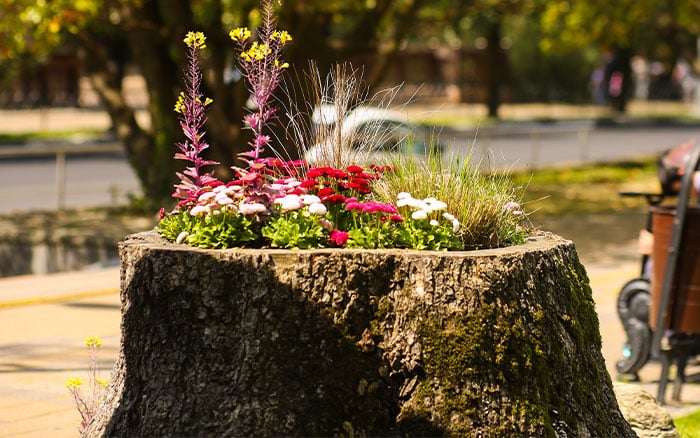Sometimes, removing trees is an essential need for your garden space. Once the tree has been cut down, however, it is best, if you can, to remove the stump and tree roots too. Find out some of the best methods to do so safely and effectively.
Trees are wonderful to have to grow in a garden. As they can be a haven for wildlife and provide shade for us to sit under during intense periods of heat. Also, they often delight with several seasons of interest.
However, there are times when trees need to be removed. A previous owner may have planted an inappropriately sized tree too close to the house with a risk of damaging foundations. The tree may have developed a disease that threatens other plants in the garden, such as honey fungus. Or your tree may simply be casting too much dense shade in your and your neighbour’s gardens. Whatever the reason for felling the tree, it’s often important to, where possible, also remove the tree stump and roots.

Some trees, such as Robinia pseudoacacia (Black locust) will re-sprout from a tree stump and grow away very quickly.
Other trees may have been diseased. Spores from a diseased tree’s stump and roots can spread to other trees and plants.
Both scenarios are good reasons for removing a felled tree’s stump and roots.
Smaller stumps can often be removed by digging, but larger or tougher specimens may require specialist machinery to grind the stump to sawdust.
Or you may want to use a product designed to kill off regrowth and help speed up the natural process of decomposition.
Stump grinder
Stump grinding machines can either be rented if you want to do it yourself, or, alternatively you can employ a tree surgeon or landscape contractor to do the job for you.
Either way it’s important to let the hire company or contractor know the exact dimensions of the stump. This enables them to supply the correct machine for the job.
If you decide to do the job yourself, take the time to thoroughly acquaint yourself with how the machine works and all safety features and instructions supplied before using it.
The machine does what it says, grinds the stump into sawdust particles. And so it’s a good idea to think ahead as to what to do with the accumulated sawdust before you start the process. If the tree removed was diseased you should bag up the sawdust and take it to your local recycling facility and not use it in the garden.
Sawdust from healthy trees can be used in the garden, spread around the base of plants as a mulch.

Stump decomposition
Specialist products designed to speed up the process of stump decomposition work in a similar way to weed killers and should be used with caution. Especially if you are keen to have a healthy, wildlife population in the garden. Never be tempted to use more than the manufacturer’s recommended dose.
By preventing regrowth these products can help speed up the lengthy process of natural decomposition. They work best on freshly cut, dry stumps, so avoid using after heavy rainfall.
Pre-drilling holes into the top of a wide trunk stump and pouring the product into these holes can also help speed up decomposition.
For smaller stumps that you’ve been unable to dig out, dilute the product with water in a container. And, wearing gloves to protect your skin, use a paintbrush to apply the product onto the stump’s cut surface.

Chainsaw
If you’re competent using a chain saw and don’t need to remove the stump completely, then one option is to remove soil from around the stump’s base, cut the stump down as low to the ground as possible.
And then cut criss-cross slices into the stump about 6”/15cm below the soil surface.
Bear in mind though that this can often break or damage the chain!

Mini or micro digger
If you have side or rear access to the garden and know how to operate a mini digger, this machinery can make quick and light work of pulling out a stump.
Winch
Smaller stumps can often be pulled out with a winch, in which case the tree trunk should be cut off at around 1 metre height, rather than at ground level.
This gives the winch mechanism something to attach to.
Winches can be hired, but safety training would be needed before use.

Digging out
Removing the stump by hand will save a lot of money but takes time and is hard work!
Dig out the soil from around the stump to expose the larger tree roots which will then need to be cut, using either a hand saw (if they’re substantial size) or loppers for thinner roots. A pry bar is also useful for manoeuvring roots into position for cutting.
Cut the roots into smaller sections and remove as many as possible from the area surrounding the stump.
The next step is to lever the stump up out of the ground using a combination of the pry bar and a garden spade. Some roots may remain after removal which should eventually rot down.

Rotting
Another option is to cut the stump level with the ground, sever roots joined to it and remove as many as possible.
Then cover the stump with soil and just leave it.
Hopefully in a couple of years the stump will have decomposed enough to start removing chunks of it using a spade or axe.
Alternatively you could just leave it for the soil microorganisms to continue breaking it down naturally.
Choose the best method for you and your garden when you choose to remove tree stumps and roots.

Leave A Comment